President's Message
Fellow Members,
Once again it is time to look back briefly at last year and see what we achieved, what we did, and what got out of our BAWA membership.
Way back in January we had what I think we had our first ever meeting devoted to wooden bicycles. It was very different to our usual presentations on furniture, dovetail joints, etc. The meeting showed that woodworking can cover a very broad field. Since the meeting I have come across 2 other companies that make wooden bicycles, all be it more traditional forms than the steam punk inspired work we saw in January.
We also had talks on Harpsichord building, furniture design and house remodeling.
On the training side we had lectures and classes last year on veneering/marquetry, the design of wood joints for chairs. We also had an evening discussing various ways of making mortise and tenon joints for furniture. Later in the year John Blackmore gave us a presentation on his summer course at the College of the Redwoods that was a mixture of his woodworking activities at the college intermingled with a travelogue of the North California coast area.
We also had the fun creating original pieces of furniture from sheets of construction-grade plywood for the Facebook challenge. The meeting, which was held at the Facebook workshop showed what very creative members we have in BAWA.
Our members were again very active in the local Rebuilding Together efforts. This is about our 20th year of supporting Rebuilding Together. This year we had about 20 members involved in a major Daly City project that they worked on from the obtaining the building permit to a successful sign-off a few weeks later.
Our 3rd annual woodwork show was held in October. It was hard to remember back to the time less than 3 years ago we were still debating if we should have a show or not. Would our members enter enough pieces of their work to make the show a success? One of the nice things about last year's show is that for the first time we had 3 high school students exhibiting their work. After years of decline in high school woodworking maybe the "craft" is now making a comeback? I read the other day that the TechShop is starting to offer family packages for children in the 12-17 year age group which is very encouraging. Through our shows we have now built up a library of about 150 pieces of work we can scan through for inspiration, (or to plagiarize, but we never admit to that)
Our Toy Workshop sessions were busy this year making about 100 toys to hand out to deserving charities in the Bay area. These sessions are great opportunities for members to socialize and work together for a very worthwhile cause.
I hope your 2013 is even better than 2012. Let's get all those stalled, waiting-list, projects finished and show them at a Show and Tell session.
Have a wonderful and creative New Year. Frank [Contact at: Frankramsay8@aol.com
New Members and Guests:
After Frank Ramsay called the meeting to order at 7:00 pm, we were pleased to welcome Jim Lumke and Ken Napior as a guests.
Jim recently moved to the Bay Area from Milwaukee and brought a treasure horde of exotic hardwoods with him. We look forward to seeing his work. Ken brought his reproduction of a cherry tea table (see Show and Tell below
Tonight is the annual potluck feast, and everyone was encouraged to forage for food at the refreshments counter. Featured items included pumpkin chocolate bars, persimmon brownies, Scandinavian sugar cookies, cakes, pies, sushi, pot stickers, shrimp and many more.
Announcements:
Marcus Miller, the BAWA Treasurer informed us that club dues for 2013 are now due. The amount is $35 per year for an individual, $40 for a family. Last year we had 87 members and income of $2,900, expenses of $1,600, resulting in a surplus of $1,300. Our Bank account balances at the end of 2012 totaled $5,600. The Paul Schurch class and the Annual Wood Show were breakeven propositions. Per Madsen has pointed out that the surplus was largely possible because we did not incur speaker expenses at the normal and anticipated rate.
Per Madsen reviewed the schedule for upcoming speakers at the monthly meetings:
In January BAWA's member John McCormack will talk about the Wooden Boat School in Brooklin, Maine. The meeting will also feature the annual box contest. There will be a BAWA Board meeting at 5:00 pm, preceding the regular meeting.
The February meeting will feature Bernie Lubell.
In March, Laura Mays, the Director and Lead Instructor at the College of the Redwoods, Fine Woodworking Program will join us.
Per asked for suggestions for future meetings. Some ideas presented include: vacuum bag forming and veneering techniques, and tours of BAWA member wood shops. Please tell Per about your ideas for future programs. Loy Martin, our speaker for this evening, has offered to host a tour of his workshop on an upcoming Saturday. More information will follow.
Frank Ramsay, in addition to his club presidential duties, has been acting as the refreshments provider for the past couple of years. Now he is asking for a member to volunteer to take over this task. Frank will work with the new person to make the transition easy and show them that it is a pretty simple task.
Harold Patterson reviewed the contribution of the Toy Workshops over the past year. The workshops produced almost 100 toys that will be distributed to needy kids next Saturday. The toys include periscopes, tic-tack-toe sets, airplanes, racecars, and crickets.
Neal White is donating a 6" finish plywood saw blade to the Silent Auction.
Claude Godcharles' persimmon tree is in full harvest. There is a box of persimmons for the taking, please take some. He can only eat so many persimmon brownies.
Stan Booker is here tonight so the door prizes will be awarded. We have a ways to go for the wood door prize, so step up to buy your tickets.
Loy Davis Martin, Designer, Furniture Maker

Loy designs and builds furniture at his Palo Alto studio, located on Grant Avenue. He has been a professional woodworker/designer for twenty-seven years and is largely self- taught. In earlier years, Brian Burns mentored Loy, teaching him all about jigs and fixtures. Today, Brian builds musical instruments in Fort Bragg, CA.
Loy began his presentation by addressing the woodworker's enigma: Can fine woodworking craftsmen be considered artists? In the classical or romantic definition of an artist, the artist is a single person fulfilling his own self-expression with passion, by defining and doing the art by themselves without input from others. Loy, who is friends with Gary Knox Bennett, told us that Gary has not accepted a commissioned work since 1981. He works exclusively on things he designs and builds. He builds to his own muse. He is an artist in the classical sense. Loy also recounted a conversation with James Krenov who said that you must build to suit yourself. Both sentiments clearly reflect the definition of the classical artist. And yet, Loy Martin's paradigm is more balanced. He showed us his Diagram of Creative Energy.
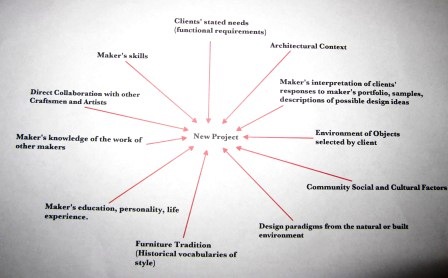
Loy meets with the client, listens to their stated needs, absorbs and interprets this information and then incorporates information from many other sources: Loy shows the client his portfolio, samples and descriptions of possible design ideas. Loy then attempts to gauge the client's emotional response, his feelings and unsaid needs. Loy will consider the tradition of furniture makers, his own education and skill set, collaborative comments from other craftsmen and artists, principles of architecture and relevant community social and cultural factors. He synthesizes all these inputs to create his own piece of studio art furniture.
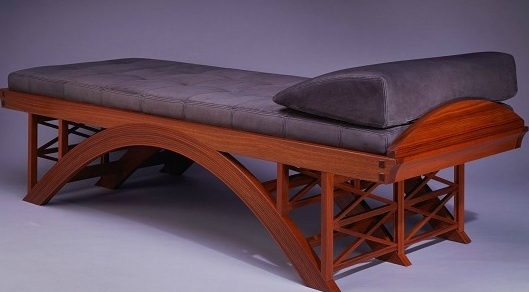
He showed us a photograph of a psychoanalyst's couch he had designed and built embodying this principle of creative energy. The psychoanalyst has distinguished himself by not being neutral, by challenging the patient. He wanted a non-neutral couch. The starting point in Loy's mind was an arched bridge he had seen in South Dakota. The couch, as shown on his website loymartinfurniture.com is built in the form of an arched bridge, meant to challenge the patient to find the structure for the support they require. The tradeoff with the client in this design process was the pillow: Loy wanted it to be integrated into and part of the mattress. The client insisted it be separate and free.
Another set of photographs showed a series of five barrel shaped chairs based loosely on a Frank Lloyd Wright design. The chairs incorporated leather murals of desert scenes that form a continuous tableau on the outside. The wood was old growth 16/4 Honduran mahogany. Loy seems to have a knack for acquiring unique and distinguished wood, then eventually finding the perfect project for it. He is in his own words, a "wood fetishist."
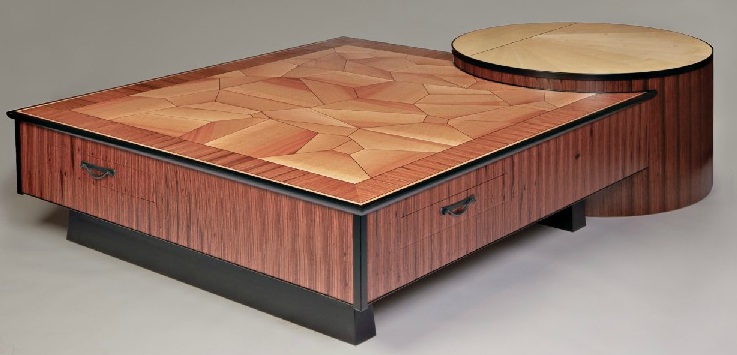
One of his most recent pieces is a large rectangular coffee table with a turret like round structure at one corner. The wood used is Brazilian Kingwood veneer, shop sawn to 2 1/2in. wide. The cracked ice pattern on the turret is Madrone.
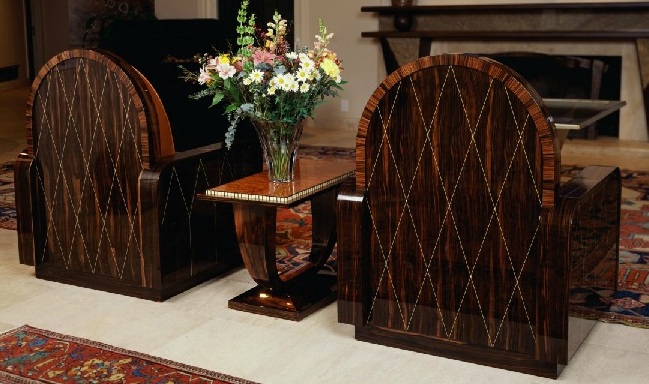
Another set of photographs showed a pair of art-deco style chairs inspired by the style of Emile-Jacques Ruhlmann. The wood is Macassar ebony veneer with a diamond pattern of holly inlay.
Loy made an executive desk with walnut veneers cut from a tree that had been downed near Auburn, California. The tree had been 15' in diameter and the veneers used in the desk were cut from the stump section. He received a $35,000 fee for the desk.
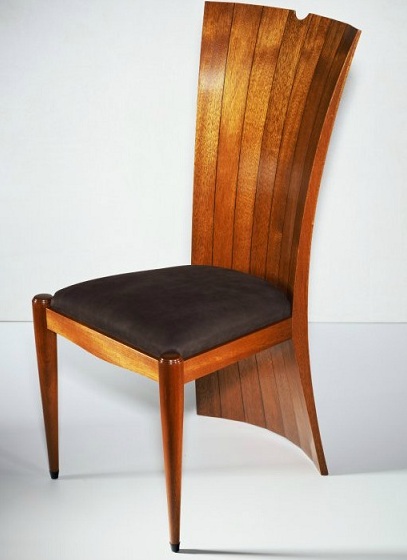
A dining room chair set of 10 chairs was designed and built with a back section consisting of joined vertical fluted sections about 4" wide stretching from the top to the floor. The back tapered to narrow widths at the top and bottom with the center where the seat was joined made at a thickness of 1 1/2in. Loy made core sections of poplar for each flute-shaped strip, then veneered each one, subsequently joining all the flutes to create one solid back. When asked by a prospective client if he would make another set of these chairs, he simply quoted an astronomical price and never heard from the person again.
A BAWA member inquired of Loy how he arrives at an estimated price for pieces of his work. Loy has developed an Estimating Book. It contains five sections, and approximately 50 task items. He has refined the book and the process over the years and finds it quite accurate. He subcontracts all finishing and upholstery work. He likes a shellac and wax finish, but prefers a lacquer finish for tables because of the increased durability of the finish.
We were shown photographs of many more pieces of Loy Martin's work. Interested readers are encouraged to view his portfolio on his website. The presentation was quite simply inspirational. There can be no doubt that the true artist is one who successfully translates the needs of the client into a work that will be treasured and endure.
To see more of Loy's work go to: loymartinfurniture.com
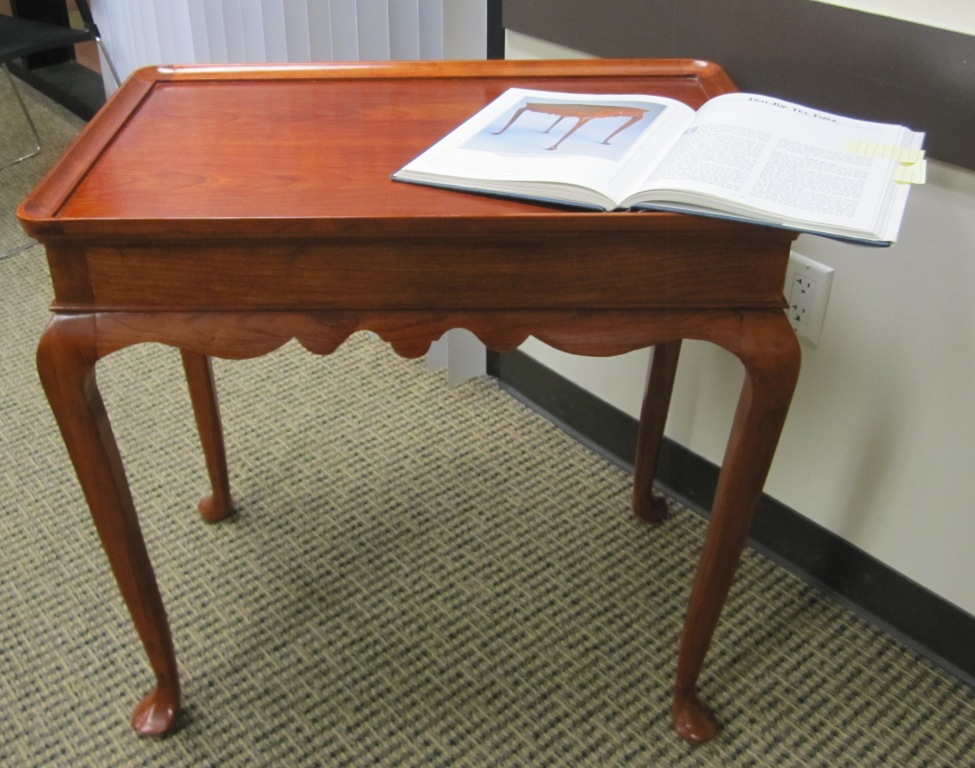
Ken Napior, a new member brought in a reproduction of a cherry tea table with Cabriolet legs. Beautifully done, even has a small pull out tray for the teacup. The finish is Transtint dyes to create an even finish, then lacquer.
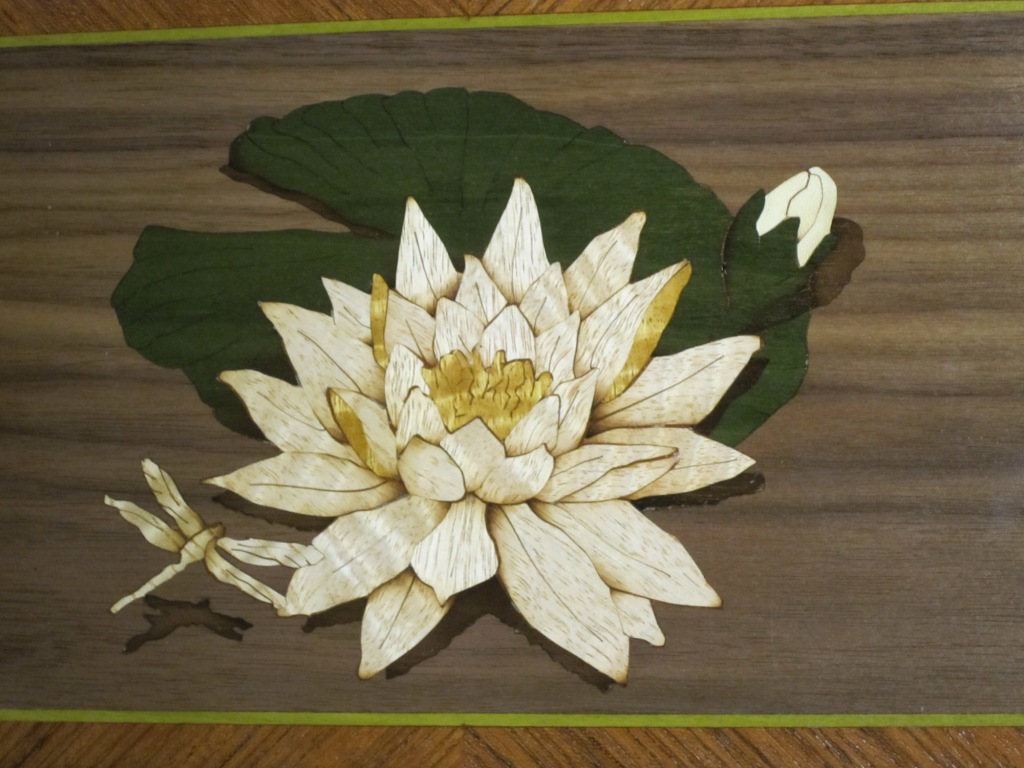

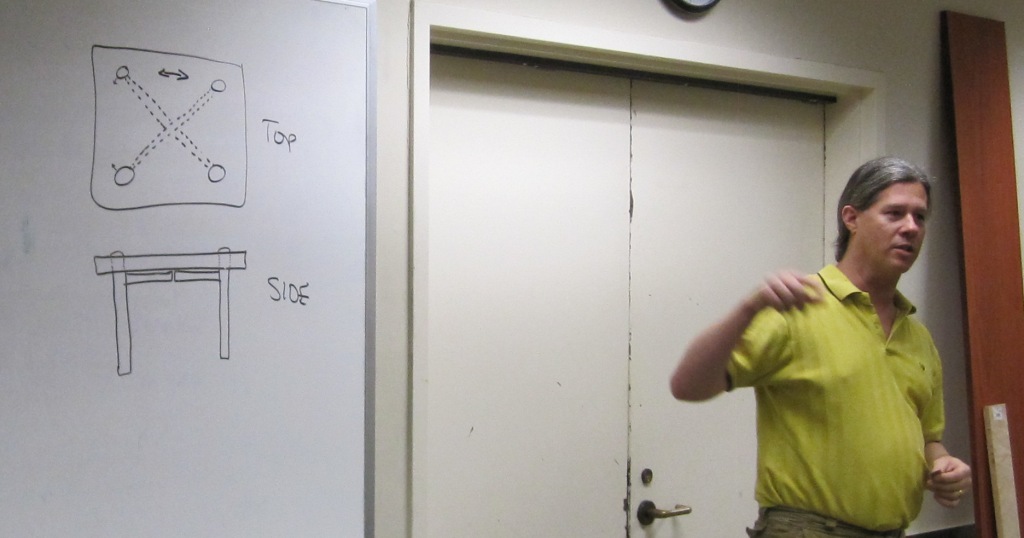
Marcus Miller described a woodworking design dilemma he confronts. He wants to build a table with a solid wood top. Crisscross stretchers join the legs to form an X-pattern. The legs project through the top of the table. He is worried that the wood movement of the top will deform the underlying leg structure. Suggestions included a veneered tabletop and/or oval holes in the top for the legs.
Frank Ramsay too has a design dilemma. He is making a cherry table with 6 five-sided legs and found the legs to weigh too much. He can lighten the weight by hollowing out the center of the legs. He achieved this by routing flutes the length of the leg to center. However, with each successive pass of the router at incremental depth increases of 1.4in. he found that he makes too many mistakes and ends up with bites along the length of the flute. Suggestions: Cut the leg in half while still in block form, hollow out the center, then glue the halves together and cut the five-sided leg; Bore out the center of the rough leg piece with a long boring bit; or don't worry about the weight.
Frank had mystery tool from cleaning out his toolbox. He asked if anyone could identify it. Just a bunch of blank stares, but Tom Gaston was busy with his smart phone. Yes, quickly came the answer: It is a tool for installing the belt on a Royal vacuum cleaner. And one BAWAer has a Royal and took the tool home.
We won the door prizes and Stan Booker successfully wrapped up another BAWA meeting.
John Blackmore johnblackmore@comcast.net
Website Tip
If you want to find the write-up on one of our passed Featured Speakers and cannot remember which month's Newsletter it is in you can find it in the
Featured Speaker Index
